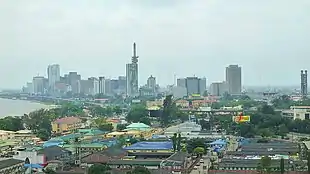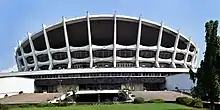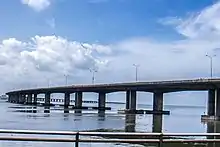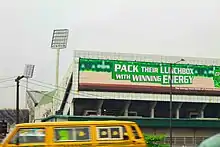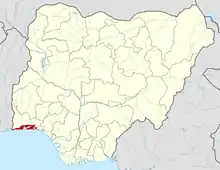Lagos
Lagos (Nigerian English: /ˈleɪɡɒs/;[11] Yoruba: Èkó) is the most populous city in Nigeria and the African continent.[12][13] Lagos is a major financial centre for all of Africa and is the economic hub of Lagos State. The megacity has the fourth-highest GDP in Africa[14][4] and houses one of the largest and busiest seaports on the continent.[15][16][17] It is one of the fastest growing cities in the world.[25]
Lagos
Èkó | |
|---|---|
Metropolis | |
| Lagos Metropolitan Area (Ìlú Èkó (Yoruba)) | |
From top, left to right: Victoria Island skyline, Ikoyi, array of skyscrapers, Lekki-Epe Expressway, National Arts Theatre. Third Mainland Bridge | |
 Flag | |
| Nickname(s): | |
| Motto(s): Èkó ò ní bàjé o! | |
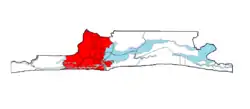 Lagos shown within the State of Lagos | |
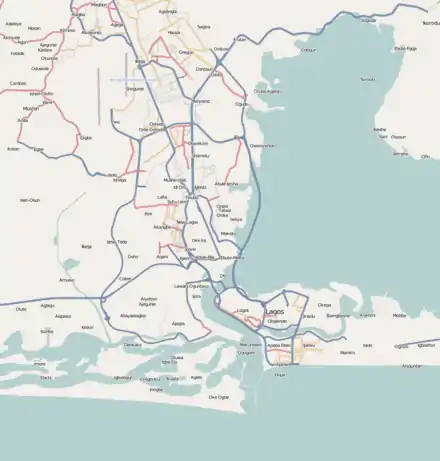 Lagos Location of Lagos in Nigeria 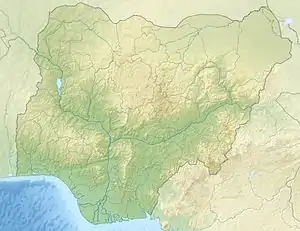 Lagos Lagos (Nigeria) 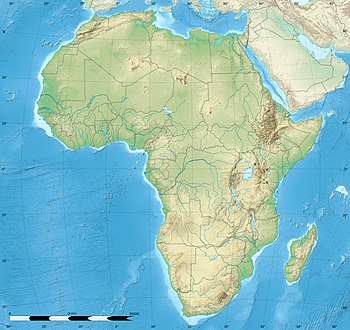 Lagos Lagos (Africa) | |
| Coordinates: 6.455027°N 3.384082°E | |
| Country | |
| State | Lagos |
| LGA(s)[note 1] | List of LGAs
|
| Settled | 15th century |
| Founded by | Awori subgroup of the Yoruba[5] |
| Government | |
| • Oba | Rilwan Akiolu I |
| Area | |
| • Metropolis | 1,171.28 km2 (452.23 sq mi) |
| • Land | 999.6 km2 (385.9 sq mi) |
| • Water | 171.68 km2 (66.29 sq mi) |
| • Urban | 907 km2 (350 sq mi) |
| • Metro | 2,706.7 km2 (1,045.1 sq mi) |
| Elevation | 41 m (135 ft) |
| Population (2006 census)[note 2] | |
| • Metropolis | 8,048,430 |
| • Estimate (2018 by LASG[7]) | 23,437,435 |
| • Rank | 1st |
| • Density | 6,871/km2 (17,800/sq mi) |
| • Urban | 13,123,000[8] |
| • Urban density | 14,469/km2 (37,470/sq mi) |
| • Metro | 21,000,000 (estimated)[9] |
| • Metro density | 7,759/km2 (20,100/sq mi) |
| Demonym(s) | Lagosian |
| Time zone | UTC+1 (WAT (UTC+1)) |
| Area code(s) | 010[10] |
| Climate | Aw |
| |
Lagos initially emerged as a home to the Awori subgroup of the Yoruba of West Africa and later emerged as a port city that originated on a collection of islands, which are contained in the present day Local Government Areas (LGAs) of Lagos Island, Eti-Osa, Amuwo-Odofin and Apapa. The islands are separated by creeks, fringing the southwest mouth of Lagos Lagoon, while being protected from the Atlantic Ocean by barrier islands and long sand spits such as Bar Beach, which stretch up to 100 km (62 mi) east and west of the mouth. Due to rapid urbanization, the city expanded to the west of the lagoon to include areas in the present day Lagos Mainland, Ajeromi-Ifelodun and Surulere. This led to the classification of Lagos into two main areas: the Island, which was the initial city of Lagos, before it expanded into the area known as the Mainland.[26] This city area was governed directly by the Federal Government through the Lagos City Council, until the creation of Lagos State in 1967, which led to the splitting of Lagos city into the present day seven Local Government Areas (LGAs), and an addition of other towns (which now make up 13 LGAs) from the then Western Region to form the state.[27]
Lagos, the capital of Nigeria since its amalgamation in 1914, went on to become the capital of Lagos State after its creation. However, the state capital was later moved to Ikeja in 1976, and the federal capital moved to Abuja in 1991. Even though Lagos is still widely referred to as a city, the present-day Lagos, also known as "Metropolitan Lagos", and officially as "Lagos Metropolitan Area"[28][29][30] is an urban agglomeration or conurbation,[31] consisting of 16 LGAs including Ikeja, the state capital of Lagos State.[4][32] This conurbation makes up 37% of Lagos State's total land area, but houses about 85% of the state's total population.[4][27][33]
The exact population of Metropolitan Lagos is disputed. In the 2006 federal census data, the conurbation had a population of about 8 million people.[34] However, the figure was disputed by the Lagos State Government, which later released its own population data, putting the population of Lagos Metropolitan Area at approximately 16 million.[note 3] As of 2015, unofficial figures put the population of "Greater Metropolitan Lagos", which includes Lagos and its surrounding metro area, extending as far as into Ogun State, at approximately 21 million.[3][27][35][36]
History

Lagos was originally inhabited by the Awori subgroup of the Yoruba people in the 15th century.[23][37][38][5] Under the leadership of the Oloye Olofin, the Awori moved to an island now called Iddo and then to the larger Lagos Island.[39][40] In the 16th century, the Awori settlement was conquered by the Benin Empire and the island became a Benin war-camp called "Eko" under Oba Orhogbua, the Oba of Benin at the time.[41][42] Eko is still the native name for Lagos.
Lagos (Portuguese for "lakes") was a name given to the settlement by the Portuguese. Throughout history, it was home to a number of warring ethnic groups who had settled in the area. Following its early settlement by the Awori nobility, and its conquest by the Bini warlords of Benin, the state first came to the attention of the Portuguese in the 15th century.[43]
Portuguese explorer Rui de Sequeira visited the area in 1472, naming the area around the city Lago de Curamo, which means Lake of Curamo. Another explanation is that Lagos is named after a major port in Portugal—a maritime town that, at the time, was the main centre of Portuguese expeditions down the African coast.
In Britain's early 19th century fight against the transatlantic slave trade, its West Africa Squadron or Preventative Squadron as it was also known, continued to pursue Portuguese, American, French and Cuban slave ships and to impose anti-slavery treaties with West African coastal chiefs with so much doggedness that they created a strong presence along the West African coast from Sierra Leone all the way to the Niger Delta (today's Nigeria) and as far south as Congo.[44] In 1849, Britain appointed John Beecroft Consul of the Bights of Benin and Biafra, a position he held (along with his governorship of Fernando Po) until his death in 1854.[45] John Duncan was appointed Vice Consul and was located at Wydah.[46] At the time of Beecroft's appointment, the Kingdom of Lagos (under Oba Kosoko) was in the western part of the Consulate of the Bights of Benin and Biafra and was a key slave trading port.[47] In 1851 and with pressure from liberated slaves who now wielded political and business influence, Britain intervened in Lagos in what is now known as the Bombardment of Lagos or Capture of Lagos[47][48] resulting in the installation of Oba Akitoye and the ouster of Oba Kosoko. Oba Akitoye then signed the Treaty between Great Britain and Lagos abolishing slavery. The signing of the 1852 treaty ushered in the Consular Period in Lagos' history wherein Britain provided military protection for Lagos.[49][50]
Following threats from Kosoko and the French who were positioned at Wydah, a decision was made by Lord Palmerston (British Prime Minister) who noted in 1861, "the expediency of losing no time in assuming the formal Protectorate of Lagos".[51] William McCoskry, the Acting Consul in Lagos with Commander Bedingfield convened a meeting with Oba Dosunmu on 30 July 1861 aboard HMS Prometheus where Britain's intent was explained and a response to the terms were required by August 1861. Dosunmu resisted the terms of the treaty but under the threat to unleash violence on Lagos by Commander Bedingfield, Dosunmu relented and signed the Lagos Treaty of Cession on 6 August 1861.[48][52][53]
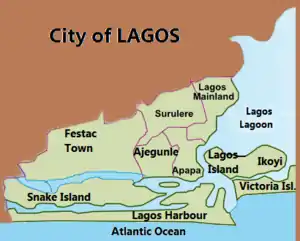
Lagos was declared a colony on 5 March 1862. The remainder of modern-day Nigeria was seized in 1887, and when the Colony and Protectorate of Nigeria was established in 1914, Lagos became its capital, continuing as such after the country's independence from Britain in 1960. Along with migrants from all over Nigeria and other West African nations were the returnee ex-slaves known as Creoles, who came from Freetown, Sierra Leone, Brazil and the West Indies to Lagos. The Creoles contributed to Lagos' modernisation and their knowledge of Portuguese architecture can still be seen from the architecture on Lagos Island. Since the 19th century, Lagos gradually transformed to a melting pot of Africans and Europeans.[54][55][5][56] Railway links and telephone cables connecting Lagos to London had been established by 1886.[57][58][59] Electric street lighting was introduced in the city in 1898.[41][60] Lagos experienced rapid growth throughout the 1960s and 1970s as a result of Nigeria's economic boom.[61]
Before the creation of Lagos State on 27 May 1967, Lagos, which was the country's capital had been administered directly by the Federal Government as a Federal Territory through the Federal Ministry of Lagos Affairs, while the Lagos City Council (LCC) governed the city.[27] Lagos, along with the towns from the then Western region (Ikeja, Agege, Mushin, Ikorodu, Epe and Badagry), were eventually captured to create Lagos State.[27] Lagos city was split into the present day seven Local Government Areas (LGAs), while the other towns now make up 13 LGAs in the state. Lagos played the dual role of being the State and Federal Capital until 1976 when the state capital was moved to Ikeja. Lagos was adversely affected during Nigeria's military rule.[62] Also, on 12 December 1991, the seat of the Federal Government was also formally relocated to Abuja. However, Lagos remains the financial centre of the country, and also grew to become the most populous conurbation in the country.[27]
Geography
Lagos is loosely classified into two main geographical areas—the "Island" and the "Mainland".
Island
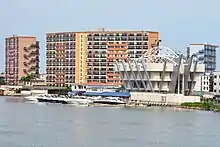
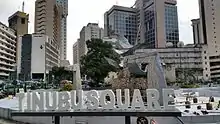
The Island is a loose geographical term that is used to define the area of Lagos that is separated from the "mainland" by the main channel draining the lagoon into the Atlantic Ocean, which forms Lagos Harbour. The Island is mainly a collection of islands that are separated from each other by creeks of varying sizes and are connected by bridges. The smaller sections of some creeks have been dredged and built over. This part of Lagos is the area where most business activities and entertainment events in Lagos takes place. It also houses most of the upscale residential areas in Lagos. The local government areas (LGAs) that are considered to be in the Island include Lagos Island, Eti-Osa. The major upscale island neighbourhoods within these LGAs include Ikoyi and Victoria Island. Three major bridges join the island to the mainland. They are the Carter Bridge, which starts from Iddo; the Eko Bridge (formerly called the Second Mainland Bridge); and the Third Mainland Bridge, which passes through densely populated mainland suburbs to the Lagos Lagoon. A fourth bridge, The Ikoyi link bridge, links Ikoyi and Lekki Phase 1, both of which are part of the Island.
Lagos Island
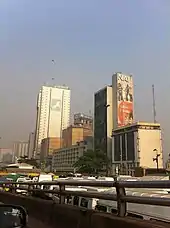
Lagos Island contains a central business district.[63] This district is characterized by high-rise buildings. The island also contains many of the city's largest wholesale marketplaces (such as the popular Idumota and Balogun Markets).[64] It also has the National Museum of Nigeria, the Central Mosque, the Glover Memorial Hall, Christ's Church Cathedral (CMS) and the Oba's Palace (Iga Idunganran).[65] Another major part of Lagos Island is Marina. It borders around the idumota and Balogun markets and houses major Banking institutions. Though formerly in a derelict condition, Lagos Island's Tinubu Square is a site of historical importance; it was here that the Amalgamation Ceremony that unified the North and South protectorate to form Nigeria took place in 1914.
Ikoyi
Ikoyi is situated on the eastern half of Lagos Island and joined to it by a land fill.[66] Ikoyi is also connected to Victoria Island by Falomo bridge, which carries the main road over Five Cowrie creek.[67] Ikoyi housed the headquarters of the federal government of Nigeria and other buildings owned by the government, including the old federal secretariat complex. The complex today is on reestablishment.[68]
In Ikoyi there are military and police barracks, a top-security prison and a federal high court of Nigeria. Ikoyi also has a number of hotels, night clubs, a recreational park and one of Africa's largest golf courses. Originally a middle class neighbourhood, in recent years, it has become a fashionable residential enclave for the upper middle class to the upper class. There are also commercial activities in Ikoyi, which is spotted in an increasing number of offices, banks, and shopping complexes. The commercial section is concentrated in the South-West.
Victoria Island
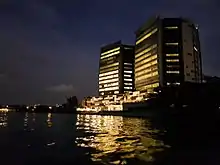
Victoria Island with its annexe is situated to the south of Lagos Island.[61] It has expensive real estate properties and for that reason, many new luxury condos and apartments are blooming up everywhere. Along with Ikoyi, Victoria Island occupies a major area in Lagos that boasts of several sizeable shopping districts. On its sea shore along the Atlantic front, there is environmentally reconstructed Bar Beach.
Iddo
Across the main channel of the lagoon from Lagos Island, there is a smaller settlement called Iddo. Iddo is also a railroad terminus and it is now situated in the Lagos Mainland local government area after it was connected to the mainland like a peninsula.[69]
Mainland
A huge population of Lagosians also live on the Lagos mainland, and most industries are located there. The mainland is known for its music and nightlife, which used to be located in areas around Yaba and Surulere. However, in recent years more night clubs have sprung up on the Island, making the Island (particularly Victoria Island, Ikate and Lekki Phase 1) the main nightlife attractions. Mainland LGAs include Surulere, Apapa, and Lagos Mainland. Metropolitan Lagos suburban LGAs include: Agege, Amuwo Odofin, Mushin, Oshodi-Isolo and Ikeja (site of Murtala Muhammed International Airport and the capital of Lagos State).
Major Areas on the mainland include Ebute Metta, Yaba and Ejigbo. Some rivers, like Badagry Creek, flow parallel to the coast for some distance before exiting through the sand bars to the sea.
Climate
Lagos experiences a tropical savanna climate (Aw) according to the Köppen climate classification, as there's a significant precipitation difference between the wet season and the dry season. The wet season starts in April and ends in October, while the dry season starts in November and ends in March. The wettest month is June with precipitation total 315.5 millimetres (12.42 in), while the driest month is January with precipitation total 13.2 millimetres (0.52 in).
Located near the equator, Lagos has only a slight seasonal temperature variation, with high temperatures ranging 28.3–32.9 °C (82.9–91.2 °F). Lagos shares the seasons of the Southern Hemisphere, with summer highs in March, daily range 32.9–24.1 °C (91.2–75.4 °F), and warm winters in August, ranging 28.3–21.8 °C (82.9–71.2 °F) as the daily average.
| Climate data for Lagos (Murtala Muhammed International Airport) 1961–1990, extremes: 1886–present | |||||||||||||
|---|---|---|---|---|---|---|---|---|---|---|---|---|---|
| Month | Jan | Feb | Mar | Apr | May | Jun | Jul | Aug | Sep | Oct | Nov | Dec | Year |
| Record high °C (°F) | 40.0 (104.0) |
37.1 (98.8) |
37.0 (98.6) |
39.6 (103.3) |
37.0 (98.6) |
37.6 (99.7) |
33.2 (91.8) |
33.0 (91.4) |
33.2 (91.8) |
33.7 (92.7) |
39.9 (103.8) |
36.4 (97.5) |
40.0 (104.0) |
| Average high °C (°F) | 32.2 (90.0) |
33.2 (91.8) |
32.9 (91.2) |
32.2 (90.0) |
30.9 (87.6) |
29.3 (84.7) |
28.2 (82.8) |
28.3 (82.9) |
28.9 (84.0) |
30.3 (86.5) |
31.4 (88.5) |
31.8 (89.2) |
30.8 (87.4) |
| Daily mean °C (°F) | 27.3 (81.1) |
28.4 (83.1) |
28.5 (83.3) |
28.0 (82.4) |
27.0 (80.6) |
25.6 (78.1) |
25.2 (77.4) |
25.0 (77.0) |
25.5 (77.9) |
26.4 (79.5) |
27.2 (81.0) |
27.2 (81.0) |
26.8 (80.2) |
| Average low °C (°F) | 22.4 (72.3) |
23.7 (74.7) |
24.1 (75.4) |
23.7 (74.7) |
23.2 (73.8) |
21.9 (71.4) |
22.3 (72.1) |
21.8 (71.2) |
22.1 (71.8) |
22.4 (72.3) |
23.0 (73.4) |
22.5 (72.5) |
22.8 (73.0) |
| Record low °C (°F) | 12.6 (54.7) |
16.1 (61.0) |
14.0 (57.2) |
14.9 (58.8) |
20.0 (68.0) |
21.2 (70.2) |
15.0 (59.0) |
19.0 (66.2) |
13.0 (55.4) |
17.9 (64.2) |
11.1 (52.0) |
11.6 (52.9) |
11.1 (52.0) |
| Average precipitation mm (inches) | 13.2 (0.52) |
40.6 (1.60) |
84.3 (3.32) |
146.3 (5.76) |
202.4 (7.97) |
315.5 (12.42) |
243.0 (9.57) |
121.7 (4.79) |
160.0 (6.30) |
125.1 (4.93) |
39.7 (1.56) |
14.8 (0.58) |
1,506.6 (59.31) |
| Average precipitation days (≥ 1.0 mm) | 1.5 | 2.8 | 6.6 | 9.0 | 12.5 | 16.2 | 13.2 | 11.6 | 12.7 | 11.2 | 4.9 | 2.1 | 104.3 |
| Average relative humidity (%) | 81 | 79 | 76 | 82 | 84 | 87 | 87 | 85 | 86 | 87 | 84 | 82 | 83 |
| Mean monthly sunshine hours | 164.3 | 168.0 | 173.6 | 180.0 | 176.7 | 114.0 | 99.2 | 108.5 | 114.0 | 167.4 | 186.0 | 192.2 | 1,843.9 |
| Source 1: Deutscher Wetterdienst (humidity, 1952–1967),[70] NOAA (sun)[71] | |||||||||||||
| Source 2: Meteo Climat (record highs and lows)[72] | |||||||||||||
Cityscape
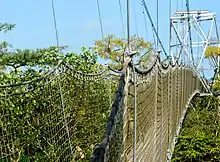
Lagos has the tallest skyline in Nigeria. The architectural styles in Lagos are diverse and range from tropical and vernacular to colonial European and ultramodern buildings or a mixture. Brazilian style architecture brought by the creoles is evident in buildings such as Water House and Shitta Bey Mosque.[73][74][75] Skyscrapers and most high rise buildings are centered on the islands, while the mainland has some high rise buildings.[76] In recent years, the Lagos State government has renovated existing parks and green areas, with a long-term goal of expansion. Many good quality buildings are interspersed across the city.[77][78][79][80][81]
Places of worship
Among the places of worship, there are Christian churches and temples: Church of Nigeria (Anglican Communion), Presbyterian Church of Nigeria (World Communion of Reformed Churches), Nigerian Baptist Convention (Baptist World Alliance), The Apostolic Church Nigeria (TACN), Living Faith Church Worldwide, Redeemed Christian Church of God, Assemblies of God, Roman Catholic Archdiocese of Lagos (Catholic Church) and Muslim mosques such as Lagos Central Mosque in Lagos- island, Wahab Folawiyo Central Mosque in Surulere, Lekki Central Mosque in Lekki, The Syrian Mosque in Ikoyi. There are also various shrines and temples for traditional worshipers scattered across the state and they include several Igbo Igunnuko shrines, Egungun shrines, Eyo Shrines and other various traditional shrines and places of worship.[82] For the 25,000 strong Hindu community, there is an ISKCON temple and three other Hindu temples dotted around the city.
Demographics
In terms of administration, Lagos is not a single municipality and therefore has no overall city administration.[83] The geographical city limits of Metropolitan Lagos comprises 16 of the 20 Local Government Areas, which together comprise Lagos State. The latter entity provides overall government for the metropolitan region. The Municipality of Lagos, which covered Lagos Island, Ikoyi, and Victoria Island as well as some mainland territory, was managed by the Lagos City Council (LCC), but it was disbanded in 1976 and divided into several Local Government Areas (most notably Lagos Island LGA, Lagos Mainland LGA and Eti-Osa LGA).[84]
The mainland beyond the Municipality of Lagos, on the other hand, comprised several separate towns and settlements such as Mushin, Ikeja and Agege. In the wake of the 1970s Nigerian oil boom, Lagos experienced a population explosion, untamed economic growth, and unmitigated rural migration. This caused the outlying towns and settlements to develop rapidly, thus forming the present day "Lagos Metropolitan Area", also known as "Metropolitan Lagos". The history of Lagos is still evidenced in the layout of the LGAs that display the unique identities of the cultures that created them.
By 2006, the metro area around Lagos had extended beyond Lagos State's boundaries and attained a megacity status. This much larger area is referred to as "Greater Metropolitan Lagos" or "Lagos Megacity Region", which is a continuous built up land area of additional 1,535.4 square kilometres (592.8 square miles), comprising sprawls in LGAs situated next to Lagos' eastern and western city limits in Lagos State, and beyond northern limits, spilling into the LGAs in adjoining Ogun State. Ogun State LGAs within Greater Metropolitan Lagos majorly include: Obafemi Owode, Sagamu, Ifo, Ado-Odo/Ota and part of Ewekoro.[36]
| Local Government Area | Land area[85] (in km2) | Population[34] (2006 Census) | Density (inh. per km2) |
| Agege | 17 | 459,939 | 41,071 |
| Ajeromi-Ifelodun | 13.9 | 684,105 | 55,474 |
| Alimosho | 137.8 | 1,277,714 | 6,899 |
| Amuwo-Odofin | 179.1 | 318,166 | 2,364 |
| Apapa | 38.5 | 217,362 | 8,153 |
| Eti-Osa | 299.1 | 287,785 | 1,496 |
| Ifako-Ijaiye | 43 | 427,878 | 16,078 |
| Ikeja | 49.92 | 313,196 | 6,785 |
| Kosofe | 84.4 | 665,393 | 8,174 |
| Lagos Island | 9.26 | 209,437 | 24,182 |
| Lagos Mainland | 19.62 | 317,720 | 16,322 |
| Mushin | 14.05 | 633,009 | 36,213 |
| Ojo | 182 | 598,071 | 3,781 |
| Oshodi-Isolo | 41.98 | 621,509 | 13,886 |
| Somolu | 14.6 | 402,673 | 34,862 |
| Surulere | 27.05 | 503,975 | 21,912 |
| Metropolitan Lagos | 1,171.28 | 7,937,932 | 7,941 |

Today, the word Lagos most often refers to the urban area, called "Metropolitan Lagos" in Nigeria, which includes both the islands of the former municipality of Lagos and the mainland suburbs. Lagos State government is responsible for some of the utilities including roads and transportation, power, water, health and education. Metropolitan Lagos extends over 16 of the 20 LGAs of Lagos State, and contains about 85% of the population of Lagos State, and includes semi-rural areas.[86] Lagos City has a considerable number of high-rise buildings that dominate its skyline. Most of the tall buildings are located in the downtown Central Business District.
Lagos was the former capital city of Nigeria but it has since been replaced by Abuja. Abuja officially gained its status as the capital of Nigeria on 12 December 1991, although the decision to move the federal capital had been made in now Act no. 6 of 1976. Lagos is also home to the High Court of the Lagos State Judiciary, housed in an old colonial building on Lagos Island.[87]
Census data for Lagos
Although the 2006 National Population Census of Nigeria credited the metropolitan area with a population figure of 7,937,932, the figure is at variance with some projections by the UN and other population agencies and groups worldwide. The population figure of Lagos State given by the Lagos State Government is 17,553,924. It was based on claimed conducted enumeration for social planning by the Lagos State Government "parallel census" and it believes that since the inhabitants of the metropolitan area of Lagos constitute 88% of the Lagos State population, the population of metropolitan Lagos is about 15.5 million.[88]
A rejoinder to Lagos State Government views[89] concluded that Lagos State concealed the fact that the population projection, for Lagos Urban Agglomeration by the UN agencies had been revised downwards substantially as early as 2003. It failed to interpret the two most important and fairly representative and reliable secondary data sets already in public domain, the National Identity Card Scheme and the 2003 Voters Registration figures from INEC. The figures for 2007 Voters Registration by INEC were an act subsequent to the release of the provisional census results and comprehensively corroborate, vindicate and validate the population figures in no uncertain terms. According to the official results of the 2006 census, there were 8,048,430 inhabitants in Metropolitan Lagos.[34] This figure was lower than anticipated, and has created controversy in Nigeria. Lagos Island, the central Local Government Area and historic centre of Metropolitan Lagos, had a population of 212,700 at the 2006 Census.[90]
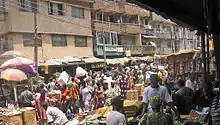
Authorities of Lagos State have attacked the results of the 2006 census, accusing the Nigerian National Population Commission of having undercounted the population of the state. This accusation is denied by the National Population Commission.[91][92] A study found that research carried out by Africapolis (the African subsidiary of e-Geopolis backed by the Agence française de développement), in addition to the cross-referencing of official figures with more scientific independent research concluded that the 2006 census figures for Lagos State of about 9 million were valid and that the state's own assessments are inflated.[93]
Lagos is, by most estimates, one of the fastest-growing cities in the world.[94] Lagos is currently experiencing a population increase of about 275,000 persons per annum. In 1999 the United Nations predicted that the city's metropolitan area, which had only about 290,000 inhabitants in 1950, would exceed 20 million by 2010 and thus become one of the ten most populated cities in the world.
There is a huge spectrum of wealth distribution among the people that reside in Lagos. It ranges from the very wealthy to the very poor. Lagos has attracted many young people and families seeking a better life from all other parts of Nigeria and beyond[62] and this has also contributed to its cosmopolitan status.[95][96][97][98][99]
| Year | Pop. | ±% |
|---|---|---|
| 1950 | 325,218 | — |
| 1960 | 762,418 | +134.4% |
| 1970 | 1,413,528 | +85.4% |
| 1980 | 2,572,218 | +82.0% |
| 1990 | 4,764,093 | +85.2% |
| 2000 | 7,280,706 | +52.8% |
| 2010 | 10,441,182 | +43.4% |
| 2019 | 13,903,620 | +33.2% |
| source:[100] for Lagos Agglomeration | ||
Economy

The city of Lagos is a major economic focal point in Nigeria, generating around 10% of the country's GDP. Most commercial and financial business is carried out in the central business district situated on the island. This is also where most of the country's commercial banks, financial institutions and major corporations are headquartered. Lagos is also the major Information Communications and Telecommunications (ICT) hub of West Africa and potentially, the biggest ICT market in the continent.[101] Lagos is developing a 24-hour economy[102][103] and has also been ranked as one of the most expensive cities in the world.[104][105][106][107][108][109] In some parts of Lagos, residents have one of the highest standards of living in Nigeria and in Africa.[110][111] At the same time, a sizable proportion of the residents live in slums without access to piped water and sanitation.[112][113][114][115][116]
The Port of Lagos is Nigeria's leading port and one of the largest and busiest in Africa. It is administered by the Nigerian Ports Authority and it is split into three main sections: Lagos port, in the main channel next to Lagos Island, Apapa Port (site of the container terminal) and Tin Can Port, both located in Badagry Creek, which flows into Lagos Harbour from the west.[117] The port features a railhead. The port has seen growing amounts of crude oil exported, with export figures rising between 1997 and 2000.[118] Oil and petroleum products provide 14% of GDP and 90% of foreign exchange earnings in Nigeria as a whole.[119]
Culture
Music and film industry
Lagos is famous throughout Africa for its music scene. Lagos has a vibrant nightlife[103][120][121] and has given birth to a variety of styles such as Sakara music, Nigerian hip hop, highlife, juju, fuji, Afrobeat, and Afrobeats.[122]
Lagos is the centre of the Nigerian movie industry, often referred to as 'Nollywood'. Idumota market on Lagos Island is the primary distribution centre. Many films are shot in the Festac area of Lagos, where the World Festival of Black Arts was held.[123]
Iganmu is home to the primary centre for the performing arts and artistes in Nigeria: the National Arts Theatre.
James Brown performed in Lagos in 1970.[124] Paul McCartney recorded his fifth post-Beatles album, Band on the Run, in an EMI studio in Lagos in August and September 1973.[125] Other foreign musicians who have also performed in the city include Sean Paul, Snoop Dogg,[126] 50 Cent, Akon, Jarule, Ashanti, Usher, Shaggy,[127] R Kelly,[128] Cardi B, Migos especially during the Star Mega Jam; Shakira, John Legend, Boyz II Men[129] T-Pain, Brian McKnight, JayZ,[130] Mary J. Blige,[131] Beyoncé, Brandy, Ciara, Keri Hilson and Lauryn Hill, among others.[132][133]
Sports
Association football is Lagos' most popular sport. Prominent Lagos football clubs include Bridge Boys F.C. MFM F.C. and First Bank: both play in Nigeria National League, the second tier of Nigerian football.
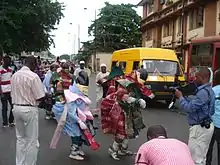
The Nigeria national football team, also known as the Super Eagles, used to play almost all of their home games in Lagos at the National Stadium in Surulere; much later, games were played at the then New Abuja National Stadium in Abuja for sometime; however, games are now mostly played at the newer Godswill Akpabio International Stadium in Uyo, which is the default home of the Super Eagles. Lagos also hosted the 2nd All-African games in 1973.[134][135][136]
Tourism
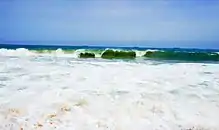

Lagos, subsequent to the re-modernization project achieved by the previous administration of Governor Raji Babatunde Fashola, is gradually becoming a major tourist destination, being one of the largest cities in Africa and in the world. Lagos is currently taking steps to become a global city and is rated as Beta - by the Globalization and World Cities Research Network.[137] The 2009 Eyo carnival (a yearly festival originated from Iperu Remo, Ogun State), which took place on 25 April, was a step toward world city status. Currently, Lagos is primarily known as a business-oriented and a fast-paced community.[86]
Lagos has become an important location for African and "black" cultural identity.[138] Many festivals are held in Lagos; festivals vary in offerings each year and may be held in different months. Some of the festivals are Festac Food Fair held in Festac Town Annually, Eyo Festival, Lagos Black Heritage Carnival, Lagos Carnival, Eko International Film Festival, Lagos Seafood Festac Festival, LAGOS PHOTO Festival and the Lagos Jazz Series, which is a unique franchise for high-quality live music in all genres with a focus on jazz. Established in 2010, the popular event takes place over a 3–5 day period at selected high quality outdoor venues. The music is as varied as the audience itself and features a diverse mix of musical genres from rhythm and blues to soul, Afrobeat, hip hop, bebop, and traditional jazz. The festivals provide entertainment of dance and song to add excitement to travelers during a stay in Lagos.
Lagos has a number of sandy beaches by the Atlantic Ocean, including Elegushi Beach and Alpha Beach. Lagos also has a number of private beach resorts including Inagbe Grand Beach Resort and several others in the outskirts.
Lagos has a variety of hotels ranging from three star to five star hotels, with a mixture of local hotels such as Eko Hotels and Suites, Federal Palace Hotel and franchises of multinational chains such as Intercontinental Hotel, Sheraton and Four Points by Sheraton. Other places of interest include the Tafawa Balewa Square, Festac town, The Nike Art Gallery, Freedom Park, Lagos and the Cathedral Church of Christ, Lagos.
Cuisine
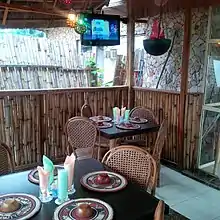
Some of the famous cuisines in Lagos include indigenous delicacies such as eba and egusi; amala and ewedu; jollof; ofada rice; plantains (locally called dodo); beans; suya (spicy shish kebab or spiced roasted beef), which is consumed in local clubs and bars with a bottle of cold beer; and eba, made from cassava and eaten with soups prepared with vegetables and mixture of spices and herbs. Other cuisines range from local ones like Iyan (pounded yam) made from yam flour, amala; asaro, which is usually eaten with various kind of vegetables; and Egusi (melon soup) to European, Middle-Eastern, and Asian cuisine.[120][139]
Education
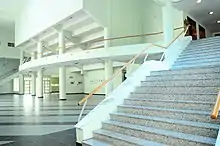

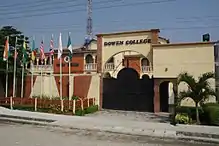
The Lagos State Government operates state schools.[140] The education system is the 6-3-3-4 system, which is practised throughout the country (as well as by many other members of the Economic Community of West African States). The levels are Primary, Junior Secondary School (JSS), Senior Secondary School (SSS) and university. All children are offered basic education, with special focus now on the first nine years. Many of the schools in Nigeria are federally funded and usually are boarding schools. A few examples are Federal government college Odogbolu (FGCOdogbolu), Federal government girls college Sagamu (FGGCSagamu) and Federal government college Kano (FGCKano). The state of Lagos has its own federally funded high schools namely Federal government college Ijanikin also known as FGC Lagos, Kings College and Queens College.
Lagos is home to various postsecondary schools, universities and other vocational institutions that are either operated by the government or private entities.[141]
Vocational schools
- Institute for Industrial Technology (IIT) : founded in 2000, IIT is a technical vocational school for male youth from families with limited resources. Its educational model is based on the Dual Training System.
Polytechnics
- Yaba College of Technology (YABATECH) : founded in 1934, the college is Nigeria's first higher educational institution and third in Africa. The college is a center of culture and heritage. Currently it has student enrolment of over 16,000.
- Lagos State Polytechnic is a polytechnic comprising more than six schools including private polytechnics and was founded 25 years ago. Its main campus resides at Ikorodu, along Shagamu road.
- Lagos City Polytechnic, located at 6/8, Bashiru Oweh Street, Off Simbiat Abiola Road (formerly Medical Road), Ikeja – This is the first private Polytechnic in Nigeria. It was established in 1990 by Engr. Babatunde Odufuwa. Engr. Odufuwa hails from Oke-Aye in Ijebu North East Local Government Area (I.N.E.L.G) of Ogun State.
- Grace Polytechnic
- Wolex Polytechnic
- Federal College of Fisheries and Marine Technology is a monotechnic that offers courses in fisheries technology, general science, marine engineering and nautical science.
- Federal College of Education (tech) Akoka
Universities

- The University of Lagos (UNILAG) Akoka, is a large institution dating from 1962, with over 55,000 students. It comprises 13 faculties, run by over 4,000 staff.[142]
- Lagos State University (LASU) is a multi-campus university established in the year 1983 and owned by the Lagos State government. The main campus is located at Ojo, along the Lagos-Badagry Expressway.
- Pan-Atlantic University formerly known as Pan-African University has a business school (LBS), a school of Media and communication (SMC) and an entrepreneurial development center (EDC), specialized in providing short courses for SMEs. Lagos Business School (LBS) is the most famous of them all, awarding world-class MBA and EMBA. The School of Media and Communication is also known for its pragmatic communication courses in the field of journalism, media and marketing. SMC awards BSc., MSc., and PHD in social science courses. Founded in 1996 and awarded University status in 2002. The University also places some emphasis on the study of art, running the Virtual Museum of Modern Nigerian Art.
- National Open University of Nigeria is the first open university in Nigeria; it is located on Ahmadu Bello Way, Victoria Island, Lagos.
- Caleb University is a private university located at Imota, Lagos.
- Lagos State College of Health Technology (LASCOHET) is an institution that runs health courses such as Health Information Management, Pharmacist Tech, Medical Laboratory Tech, Community Health Extension and Environmental Health Technology; it is located in Yaba.
- Lagos State University College of Medicine (LASUCOM), Ikeja
- Lagos University Teaching Hospital (LUTH), Idi-Araba-Mushin, Lagos.
Healthcare
Lagos has many hospitals and medical facilities, some of which have accomplished feats in Nigeria's medical history. For example, the oldest Nigerian hospital is located in the city as well as West Africa's first air-operated emergency medical service, which commenced in the city. The Lagos healthcare system is generally divided into public and private sectors that provide medical services at the primary, secondary, and tertiary levels.[143]
Transportation

Highways
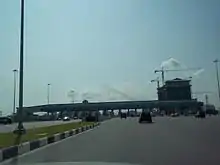
Lagos has one of the largest and most extensive road networks in West Africa.[144][145] It also has suburban trains and some ferry services. Highways are usually congested in peak hours, due in part to the geography of the city, as well as to its explosive population growth.[94][146] Lagos is also linked by many highways and bridges. A new rail system that is supposed to span the length of the Badagry expressway is currently under construction.
The Lagos–Ibadan Expressway and the Lagos–Abeokuta Expressway are the major controlled-access highways in the north of the city and serve as inter-state highways to Oyo State and Ogun State respectively. To the west the congested Lagos–Badagry Expressway serves outlying towns such as Festival Town, which was the location for the 1977 Festival of Black Arts and Culture 77.[147]
Lagos's importance as a commercial centre and port and its strategic location have led to it being the end-point of three Trans-African Highway routes using Nigeria's national roads.[148] The Trans–West African Coastal Highway leaves the city as the Badagry Expressway to Benin and beyond as far as Dakar and Nouakchott; the Trans-Sahara Highway to Algiers, which is close to completion, leaves the city as the Lagos-Ibadan Expressway.[149]
Lagos State has a bus rapid transit (BRT) system;[145] the first phase was completed in February 2008. It is expected to operate along eight routes using specially designated bus rapid transit lanes running through the city, with the aim of expanding to other routes in the future. The first phase of the Lagos BRT runs 19 km (12 mi) through Ikorodu Road and Funsho Williams Avenue up to CMS. After weeks of test runs, operations started on 17 March 2008, six months earlier than planned.[145] Also, the signature color of Lagos state 14-seater bus (known as Danfo) is yellow with a touch of black.
It has been estimated that the system will transport about 10,000 passengers in each direction per hour during peak travel times. At these times traffic congestion, called "Go Slow", by Lagosians, can be extreme.[150] The LAMATA bus rapid transit corridor covers a distance of about 22 km (14 mi). The system is run by two operators, NURTW Cooperative (Nigerian Union of Road Transport Workers) and Lagbus, a Lagos State Government owned Asset Management Company that contributes about 180 high-capacity buses for the implementation of the first phase Mile 12 to CMS BRT Lite system.
Rail
An extensive urban rail system, Lagos Rail Mass Transit, running through the Lagos metropolis is currently under construction.[94][151][152] Several intercity and commuter trains serve Lagos through the Lagos Terminus railway station.
Ferries
Lagos State Ferry Services Corporation runs a few regular routes, for example between Lagos Island and the mainland, served by modern ferries and wharves. Private boats run irregular passenger services on the lagoon and on some creeks.[153]
Air
Lagos is served by Murtala Muhammed International Airport, one of the largest and busiest airports in Africa. The MMIA is Nigeria's premier international air gateway. The airport's history dates back to colonial times, around the time of the Second World War. The current international airport terminal was built and commissioned over 40 years ago, in 1978. The terminal opened officially March 15, 1979. The airport had been known simply as the Lagos International Airport. It was, however, renamed for the late Nigerian Head of State, General Murtala Muhammed, who died in 1976.
The airport terminal has been renovated several times since the 1970s but its most radical makeover began in 2013, following the launch of the Federal government's multi-billion naira Remodelling/ Rehabilitation Programme for its airports nationwide. Under the re-modeling work there, by late in 2014, the MMlA lounge area had been expanded to four times its previous size and new passenger handling conveyor systems installed which can handle over 1,000 passengers per hour.
A second airport, Lekki-Epe International Airport is proposed.
Notable people
- Abike Dabiri, Chairman/Chief Executive Officer of the Nigerian Diaspora Commission
- Agbani Darego, Miss Nigeria 2001, Semifinalist Miss Universe 2001 and Miss World 2001
- Akinwunmi Ambode, former Governor of Lagos state
- Tunji Awojobi (born 1973), professional basketball player
- Babajide Sanwo-Olu, Governor of Lagos State
- Babatunde Fashola, Former Governor of Lagos and current Minister of Power, Works and Housing
- Bode George, Politician
- Bola Tinubu, Former Governor of Lagos State
- Buchi Emecheta, novelist
- Funsho Williams, politician and one time aspirant to the office of Lagos state governor
- Hakeem Olajuwon, professional basketball player
- Habeeb Okunola, businessman and Philanthropist
- Israel Adesanya, UFC middleweight champion
- Israel Idonije, Professional American football player, Chicago Bears 2003–2013, Detroit Lions 2013
- Kenny Adeleke (born 1983), basketball player
- Lekan Fatodu, Politician and journalist
- Nelson Agholor, Professional American football player, Super Bowl 52 Champion with the Philadelphia Eagles in 2018
- Rilwan Akiolu, Oba (traditional ruler) of Lagos
- Toyin Saraki, global health advocate and healthcare philanthropist
- Yemi Osinbajo, politician, lawyer and current Vice-President of Nigeria
- Yvonne Orji, actress, comedian
Twin towns – sister cities
Lagos is twinned with:
 Atlanta, United States[154]
Atlanta, United States[154] Belo Horizonte, Brazil[155]
Belo Horizonte, Brazil[155] Bucharest, Romania[156]
Bucharest, Romania[156]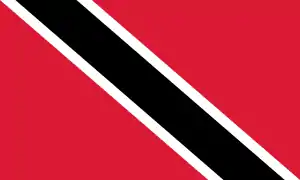 Port of Spain, Trinidad and Tobago[157]
Port of Spain, Trinidad and Tobago[157]
Notes
- Metropolitan Lagos consists of 16 of Lagos State's 20 LGAs, which excludes Badagry, Epe, Ibeju-Lekki and Ikorodu.[3][4]
- Metropolitan Lagos consists 16 out of Lagos State's 20 LGA, which excludes: Badagry, Epe, Ibeju-Lekki and Ikorodu.[3][6]
- Metropolitan Lagos consists 16 out of Lagos State's 20 LGA, which excludes Badagry, Epe, Ibeju-Lekki, and Ikorodu.[3][9]
References
- "18th National Sports Festival: Lagos unveils Logo, mascot and website". Premium Times. Abuja, Nigeria. 18 June 2012. Retrieved 2 October 2012.
- "Eko 2012: Building Branding through Sports, Articles". ThisDay. Lagos, Nigeria. 22 August 2012. Archived from the original on 24 December 2013. Retrieved 2 October 2012.
- "Metro Lagos (Nigeria): Local Government Areas". City Population. 21 March 2015. Retrieved 26 October 2015.
- "Lagos and Its Potentials for Economic Growth". 2 July 2015. Retrieved 26 October 2015.
- Ray Hutchison (2009). Encyclopedia of Urban Studies. SAGE. p. 427. ISBN 978-1-412-9143-21.
- "Lagos (State, Nigeria)". population.de. Retrieved 25 July 2016.
- Lagos Bureau of Statistics. "2019 Abstract of Local Government Statistics" (PDF). Retrieved 31 August 2020.
- Demographia (January 2015). Demographia World Urban Areas (PDF) (11th ed.). Retrieved 2 March 2015.
- "Population-Lagos State". Lagos State Government. Archived from the original on 18 October 2015. Retrieved 21 February 2016.
- Williams, Lizzie (2008). Bradt Travel Guides (3rd ed.). Paperback. p. 87. ISBN 978-1-8416-2397-9. Retrieved 26 July 2014.
- Jones, Daniel (2011). Roach, Peter; Setter, Jane; Esling, John (eds.). Cambridge English Pronouncing Dictionary (18th ed.). Cambridge University Press. ISBN 978-0-521-15255-6.
- "What Makes Lagos a Model City". New York Times. 7 January 2014. Retrieved 16 March 2015.
- John Campbell (10 July 2012). "This Is Africa's New Biggest City: Lagos, Nigeria, Population 21 Million". The Atlantic. Washington DC. Retrieved 23 September 2012.
- "These cities are the hubs of Africa's economic boom". Big Think. 4 October 2018. Retrieved 23 April 2019.
- "Africa's biggest shipping ports". Businesstech. 8 March 2015. Retrieved 26 October 2015.
- Brian Rajewski (1998). Africa, Volume 1 of Cities of the World: a compilation of current information on cultural, geographical, and political conditions in the countries and cities of six continents, based on the Department of State's "post reports". Gale Research International, Limited. ISBN 978-0-810-3769-22.
- Loretta Lees; Hyun Bang Shin; Ernesto López Morales (2015). Global Gentrifications: Uneven Development and Displacement. Policy Press. p. 315. ISBN 978-1-447-3134-89.
- African Cities Driving the NEPAD Initiative. UN-HABITAT. 2006. p. 202. ISBN 978-9-211318159.
- John Hartley; Jason Potts; Terry Flew; Stuart Cunningham; Michael Keane; John Banks (2012). Key Concepts in Creative Industries. SAGE. p. 47. ISBN 978-1-446-2028-90.
- Helmut K Anheier; Yudhishthir Raj Isar (2012). Cultures and Globalization: Cities, Cultural Policy and Governance. SAGE. p. 118. ISBN 978-1-446-2585-07.
- Stuart Cunningham (2013). Hidden Innovation: Policy, Industry and the Creative Sector (Creative Economy and Innovation Culture Se Series). Univ. of Queensland Press. p. 163. ISBN 978-0-702-2509-89.
- Lisa Benton-Short; John Rennie Short (2013). Cities and Nature. Routledge Critical Introductions to Urbanism and the City. p. 7. ISBN 978-1-134252749.
- Kerstin Pinther; Larissa Förster; Christian Hanussek (2012). Afropolis: City Media Art. Jacana Media. p. 18. ISBN 978-1-431-4032-57.
- Salif Diop; Jean-Paul Barusseau; Cyr Descamps (2014). The Land/Ocean Interactions in the Coastal Zone of West and Central Africa Estuaries of the World. Springer. p. 66. ISBN 978-3-319-0638-81.
- Sources: [18][19][20][21][22][23][24]
- "CASE STUDY OF LAGOS" (PDF). Archived from the original (PDF) on 4 March 2016. Retrieved 27 November 2015.
- "Lagos State Information". National Bureau of Statistics. Archived from the original on 9 November 2015. Retrieved 25 October 2015.
- "A Flood-Free Lagos: The Regional Imperative". Retrieved 27 November 2015.
- Olukoju, Ayodeji (1996). "The Travails of Migrant and Wage Labour in the Lagos Metropolitan Area in the Inter-War Years". Labour History Review. Liverpool University Press. 61: 49–70. doi:10.3828/lhr.61.1.49. Retrieved 27 November 2015.
- "Lagos Metropolitan Area: Scope and scale of the shelter problem". Retrieved 27 November 2015.
- Caprio, Charles (6 March 2012). "Lagos is wonderful and charming conurbation of Nigeria to visit". Go Articles. Retrieved 27 November 2015.
- "Administrative Levels - Lagos State". Nigeria Congress. Archived from the original on 25 December 2005. Retrieved 27 November 2015.
- "Population - Lagos State". Lagos State Government. Archived from the original on 18 October 2015. Retrieved 27 November 2015.
- Summing the 16 LGAs making up Metropolitan Lagos (Agege, Ajeromi-Ifelodun, Alimosho, Amuwo-Odofin, Apapa, Eti-Osa, Ifako-Ijaiye, Ikeja, Kosofe, Lagos Island, Lagos Mainland, Mushin, Ojo, Oshodi-Isolo, Shomolu, Surulere) as per:
"2006 Population Census" (PDF). National Bureau of Statistics of Nigeria. May 2007. Archived from the original (PDF) on 26 June 2011. Retrieved 14 September 2010. - "Population". Lagos State Government. 2011. Archived from the original on 18 October 2015. Retrieved 3 November 2012.
- Pacetti, M.; Passerini, G.; Brebbia, C.A.; Latini, G. (2012). The Sustainable City VII: Urban Regeneration and Sustainability. ISBN 9781845645786.
- Margaret Peil (1991). Lagos: the city is the people (World cities series). G.K. Hall. p. 5. ISBN 978-0-816-1729-93.
- Anthony Appiah; Henry Louis Gates (2010). Encyclopedia of Africa, Volume 1. Oxford University Press. p. 28. ISBN 978-0-195-3377-09.
- Sandra T. Barnes (1986). Patrons and Power: Creating a Political Community in Metropolitan Lagos. Indiana University Press, International African Library. p. 20. ISBN 978-0-2533-4297-3. Retrieved 26 July 2014.
- Francesca Locatelli; Paul Nugent (2009). African Cities: Competing Claims on Urban Spaces. Brill. p. 114. ISBN 978-9-0041-6264-8. Retrieved 26 July 2014.
- Williams, Lizzie (2008). Nigeria: The Bradt Travel Guide. Bradt Travel Guides. p. 110. ISBN 978-1-84162-239-2.
- Smith, Robert Sydney (1988). Kingdoms of the Yoruba (3 ed.). University of Wisconsin Press. p. 73. ISBN 0-299-11604-2.
- "The Origin of Eko (Lagos)". Edo Nation. Retrieved 2 June 2010.
- Smith, Robert (January 1979). The Lagos Consulate 1851-1861. Macmillan. p. 2. ISBN 9780520037465.
- Howard Temperley, "Beecroft, John (1790–1854)", rev. Elizabeth Baigent, Oxford Dictionary of National Biography, Oxford University Press, 2004
- Wikisource:Duncan, John (1805-1849) (DNB00)
- A. Adu Boahen (1985). Africa Under Colonial Domination 1880-1935 (General history of Africa). 7. Unesco. International Scientific Committee for the Drafting of a General History of Africa. p. 134. ISBN 978-9-231-0171-31.
- Sir William M.N. Geary (2013). Nigeria Under British Rule (1927). Routledge. pp. 24–28. ISBN 978-1-136-9629-43.
- "The Reduction of Lagos:Introduction". Retrieved 1 February 2015.
- Austen, R. (1 April 2009). "Slavery and the Birth of an African City: Lagos, 1760-1900, by Kristin Mann". African Affairs. 108 (431): 328–329. doi:10.1093/afraf/adp004. ISSN 0001-9909.
- Smith, Robert (January 1979). The Lagos Consulate 1851-1861. Macmillan. p. 121. ISBN 9780520037465.
- Elebute, Adeyemo (2013). The Life of James Pinson Labulo Davies: A Colossus of Victorian Lagos. Kachifo Limited/Prestige. pp. 143–145. ISBN 9789785205763.
- David Anderson; Richard Rathbone (2000). Africa's Urban Past. James Currey Publishers, 2000. p. 126. ISBN 978-0-852-5576-17.
- Kofi Agawu (2014). "19th century Lagos". Representing African Music: Postcolonial Notes, Queries, Positions. Routledge. p. 12. ISBN 978-1-317-7940-66.
- J. F. Ade Ajayi; Unesco. International Scientific Committee for the Drafting of a General History of Africa (1998). Africa in the Nineteenth Century Until the 1880s. 6. University of California Press. p. 286. ISBN 978-0-520-0670-11.
- "1914 - 2014 Colonial Footprints: Lagos, Then and Now". The Centenary Project (Google Arts and Culture). March 2014. Retrieved 14 May 2016.
- Williams, Lizzie (2008). Nigeria: The Bradt Travel Guide. Bradt Travel Guides. p. 111. ISBN 978-1-841-6223-92.
- Hans F. Ulrich; Ernst P. Lehrmann (2008). Telecommunications Research Trends. Nova Publishers. p. 144. ISBN 978-1-604-5615-86.
- Eli M. Noam (1999). Telecommunications in Africa (Global communications series). Oxford University Press. ISBN 978-0-195-3562-74.
- Ayodeji Olukoju (2003). INFRASTRUCTURE DEVELOPMENT AND URBAN FACILITIES IN LAGOS, 1861-2000. OpenEdition Books. Institut français de recherche en Afrique (IFRA-Nigeria). pp. 22–45.
- "2008 All Africa Media Research Conference" (PPT). Pan African Media Research Organisation. p. 8. Retrieved 4 April 2012.
- Robert Draper; Robin Hammond (1 January 2015). "Lagos Nigeria: Africa's First city". National Geographic. Retrieved 18 April 2016.
- "The lagos pressure group on the environment". Limge Online. Archived from the original on 10 May 2013. Retrieved 4 April 2012.
- 2008 All Africa Media Research Conference. Nigeria Tribune. 26 April 2007. p. 34.
- "Simply Lagos". The Transmitter. Archived from the original on 4 March 2016. Retrieved 4 April 2012.
- Oni, A. O (2008). "Journal of the Nigerian Institution of Estate Surveyors and Valuers: An empirical study of the Lagos state rent edict of 1997". Retrieved 4 April 2012.
- Branch of the Nigerian Institution of estate surveyors & Valuers. Lagos state. 30 August 2006.
- Ikoyi Federal secretariat … Disused monument rotting away https://m.guardian.ng/sunday-magazine/ikoyi-federal-secretariat-disused-monument-rotting-away/
- "Giant Cities Of Tiny Islands" (PDF). Archived from the original (PDF) on 5 April 2012. Retrieved 4 April 2012.
- "Klimatafel von Lagos-Ikeja (Flugh.) / Nigeria" (PDF). Federal Ministry of Transport and Digital Infrastructure. Retrieved 7 July 2016.
- "Lagos Climate Normals 1961–1990". National Oceanic and Atmospheric Administration. Retrieved 7 July 2016.
- "Station Murtala" (in French). Meteo Climat. Retrieved 7 July 2016.
- Melville J. Herskovits (5 November 2013). The Human Factor in Changing Africa. Routledge, 2013. p. 118. ISBN 978-1-136-5296-10.
- James Brook (6 September 1987). "Brazilian Houses In Nigeria Are A Legacy Of Thousands Of Freed Slaves". Chicago Tribune. New York. Retrieved 30 May 2017.
- "Five Architectural Wonders of Lagos". The Guardian. Retrieved 30 May 2017.
- Tonye Bakare (15 May 2016). "Open House Lagos opens a new vista in Lagos architecture". The Guardian. Retrieved 27 August 2017.
- Harm de Blij; Peter O. Muller (24 March 1998). Geography, Update: Realms, Regions, and Concepts. Wiley, 1998. p. 349. ISBN 9780471291121.
- Daniel Immerwahr. The Politics of Architecture and Urbanism in Postcolonial Lagos, 1960-1986. Journal of African Cultural Studies (Thesis). 19. Taylor & Francis, Ltd. p. 165-186. JSTOR 25473387.
- "A cursory look at the colonial roots of Lagos, Nigeria". Google Arts and culture (The Centenary Project). 1 March 2014. Retrieved 30 May 2017.
- "THE RISE OF FUTURE CITIES IN SUB-SAHARAN AFRICA". Cityscape. Retrieved 30 May 2017.
- Akin George - 29 November 2016. "Rising Residential Towers In Lagos: Changing The Megacity Skyline". Independent. Archived from the original on 16 August 2017. Retrieved 30 May 2017.
- J. Gordon Melton, Martin Baumann, Religions of the World: A Comprehensive Encyclopedia of Beliefs and Practices, ABC-CLIO, USA, 2010, p. 2107
- "Cities & Citizens Series:Urban Iniquities in three Cities" (PDF). Unhabit Online. Archived from the original (PDF) on 13 October 2013. Retrieved 4 April 2012.
- Dr. Dele Olowu (1992). Public Admin. Dev. Urban local government finance in Nigeria: The case of Lagos municipal area. p. 12: 19–38. doi:10.1002/pad.4230120103.
- "Metro Lagos". Retrieved 28 November 2015.
- "Managing Metropolitan Lagos" (PDF). R.Rasaki. Archived from the original (PDF) on 13 May 2012. Retrieved 4 April 2012.
- "Lagos State Judiciary". Nigeria Law Online. Archived from the original on 21 May 2013. Retrieved 4 April 2012.
- "Document". Nigerian Muse Online. 7 February 2007. Archived from the original on 8 February 2010. Retrieved 4 April 2012.
- "NATIONAL POPULATION COMMISSION – MISUNDERSTANDING, MISPERCEPTION AND MISREPRESENTATION OF CENSUS 2006 A REJOINDER TO THE PUBLICATION – "The Falsification of Lagos Census Figure" by Lagos State Government". Economicconfidential.com. Archived from the original on 29 May 2010. Retrieved 2 June 2010.
- "Legal Notice on Publication of the Details of the Breakdown of the National and State Official Totals 2006 Census" (PDF). Federal Republic of Nigeria Official Gazette. 96 (2). 2 February 2009. Archived from the original (PDF) on 4 July 2007. Retrieved 29 June 2007.
- Obasola, Kemi (5 February 2007). "Lagos rejects population commission's figures". The Punch. Punch Nigeria Limited, via Biafra Nigeria World News. Retrieved 11 December 2007.
- Government of Nigeria, National Population Commission (8 February 2007). "Lagos State Claim on the Provisional Result of the 2006 Census is Unfounded" (PDF). Archived from the original (PDF) on 23 June 2007. Retrieved 29 June 2007.
- "FACTSHEET: Nigeria's population figures". Africa Check. Retrieved 2 June 2016.
- Leonard Lawal; Eromo Egbejule; Nicholas Norbrook (5 April 2016). "Nigeria: Lagos, Maximum City". The Africa Report. Retrieved 18 April 2016.
- John David Yeadon Peel (2003). Religious Encounter and the Making of the Yoruba African Systems of Thought Series. Indiana University Press. ISBN 978-0-253-2158-88.
- Lagos State (Nigeria). Ministry of Economic Planning and Budget (2004). "State of Lagos Megacity and Other Nigerian Cities: Report". Lagos State Ministry of Economic Planning & Budget.
- Okuneye P. A.; Adebayo, K.; Opeolu B.T.; Baddru F.I. ANALYSIS OF THE INTERPLAY OF MIGRATION AND URBAN EXPANSION, ON HEALTH AND THE ENVIRONMENT: THE CASE OF LAGOS, NIGERIA (PDF) (Thesis). Committee for International Cooperation in National Research in Demography (CICRED). Retrieved 11 July 2016.
- Paul Ugbiajah. Culture-conflict and delinquency: a case study of colonial Lagos - Monash Arts (pdf) (Thesis). Retrieved 11 July 2016.
- Solimar Otero (2010). Afro-Cuban Diasporas in the Atlantic World (Rochester studies in African history and the diaspora). University Rochester Press. p. 80. ISBN 978-1-580-4632-63. ISSN 1092-5228.
- UN World Urbanization Prospects
- Douglas Zhihua Zeng (2008). Knowledge, Technology, and Cluster-based Growth in Africa (WBI development studies). World Bank Publications. p. 66. ISBN 9780821373071.
- "Ambode, Security And Lagos Quest For 24/7 Economy". PM News. 27 August 2015. Retrieved 1 October 2016.
- Stephanie Busari (1 April 2009). "24 hours in Lagos: The city that never sleeps". CNN. Retrieved 1 October 2016.
- Ruth Cyr (2001). Twentieth Century Africa. iUniverse. p. 391. ISBN 978-0-595-1898-23.
- "BLACK ENTERPRISE". Earl G. Graves, Ltd. January 1980. p. 122. ISSN 0006-4165.
- "JET". Jet : 2004. Johnson Publishing Company. 60 (10): 14. 21 May 1981. ISSN 0021-5996.
- John O. Olumide-Faoseke (2002). Lagos: the miracle city of Nigeria : street and safety guide. Keystone (Tourism) Promotion Services. ISBN 9789783077263.
- Hernando Gómez Buendía (13 July 2007). Urban crime: global trends and policies. United Nations University, 1989 (University of Michigan). p. 141. ISBN 978-9-280-8067-93.
- R. K. Raju (2002). Welcome to Nigeria: The Impossible Land. Allied Publishers. p. 15. ISBN 978-8-177-6404-27.
- Tolu Ogunlesi (4 May 2014). "Commercial hub status of Lagos sparks a chain reaction". Financial Times. Retrieved 17 March 2016.
- "Luxury living in Lagos". CNBC Africa. 21 October 2013. Archived from the original on 19 March 2016. Retrieved 16 March 2016.
- Roland K. Price; Zoran Vojinovi? (2011). Urban Hydroinformatics: Data, Models, and Decision Support for Integrated Urban Water Management. IWA Publishing. p. 492. ISBN 978-1-843-3927-43.
- "Water Supply and Sanitation in Nigeria" (PDF). WorldBank. Retrieved 30 November 2016.
- Lagos, the mega-city of slums
- In 1995 "70 percent of Lagos' population lived in slums in extremely poor environmental surroundings. Knee-deep floods sweeping raw sewage and refuse inside densely packed homes were frequent in neighborhoods where overcrowding was the norm. While the average residential density for Lagos was about 260 people per hectare, the population density in slums was between 790 and 1240 people per hectare. ", Nigeria - Lagos Metropolitan Development and Governance Project, repport of World Bank, 2006 (lookup on 2016-11-23)
- Vladimir Duthiers; Teo Kermeliotis (22 August 2012). "Lagos of the future: Megacity's ambitious plans". CNN. Retrieved 30 November 2016.
- "OT Africa Line – Nigeria Page". Otal.com. 1 February 2007. Retrieved 2 June 2010.
- "OT Africa Line – Lagos Port Statistics" (PDF). Retrieved 2 June 2010.
- "Nigeria". CIA World Factbook. 1 February 2007. Retrieved 4 April 2012.
- The University of Michigan (1992). Post Report. United States Department of State. p. 16.
- Omiko Awa (21 June 2015). "A Peep Into The Glamour, Glitz Of Lagos Nightlife". The Guardian. Retrieved 26 March 2016.
- Ayodele Ganiu (2011). "The contribution of the Creative Economy to African Cities: A Case Study of Lagos Creative Sector & Its Potential" (PDF). Archived from the original (PDF) on 9 May 2013. Retrieved 4 April 2012.
- "Yoruba Travelling Theatre & Video Film" (PDF). Retrieved 4 April 2012.
- "James Brown tours Africa for U.S. State Department". JET. Johnson Publishing Company. 38 (26): 57. 1 October 1970. ISSN 0021-5996.
- Mark Lewisohn (2001). "Band On The Run: Paul McCartney and Wings". Retrieved 8 April 2012.
- Williams, Lizzie; Shenley, Mark (2012). Nigeria. Bradt Travel Guides. p. 51. ISBN 978-1-841-6239-79.
- "Nigeria: The Shaggy Thriller in Lagos". All Africa. 2 January 2002. Retrieved 25 April 2017.
- "R Kelly storms Nigeria". The Vanguard. 11 November 2010. Retrieved 25 April 2017.
- "Nigeria: Shakira, Legend, UB40 to Star At Thisday Festival". All Africa. Retrieved 25 April 2017.
- Opeoluwa Ogunjimi. "Jay-Z coming to Nigeria". The Vanguard. Retrieved 25 April 2017.
- Anozie Egole (5 October 2013). "How Mary J. Blige rocked Lagos". The Vanguard. Retrieved 25 April 2017.
- "How 7 US celebs have visited Nigeria in six months". Nigerian Entertainment Today. 15 June 2016. Archived from the original on 26 April 2017. Retrieved 25 April 2017.
- "Nigeria: Usher Raymond is Star of the Mega Jam". All Africa. Retrieved 25 April 2017.
- "Nigeria". World Stadiums. Retrieved 2 June 2010.
- Chuka Onwumechili (3 July 2008). "Nigeria International Matches 1955–2007". Rec.Sport.Soccer Statistics Foundation Online. Retrieved 2 June 2010.
- "History of sports in Nigeria".
- "The World According to GaWC 2020". GaWC - Research Network. Globalization and World Cities. Retrieved 31 August 2020.
- Anthony Appiah; Henry Louis Gates (2010). Encyclopedia of Africa, Volume 2. Oxford University Press. p. 53. ISBN 978-0-195-3377-09.
- Kaye Whiteman (2013). Lagos: A Cultural and Literary History Volume 5 of Landscapes of the Imagination. Andrews UK Limited. ISBN 9781908493897.
- "Education". Archived from the original on 14 July 2007. Retrieved 4 April 2012.
- "Issue And Problems In Higher Edfucation" (PDF). National Open University, Nigeria. Archived from the original (PDF) on 22 May 2013. Retrieved 4 April 2012.
- "Homepage". University of Lagos official website. Retrieved 4 April 2012.
- Marleen Dekker; Rijk van Dijk (2010). Markets of Well-being: Navigating Health and Healing in Africa. 9. BRILL, African Dynamics. p. 31. ISBN 9789004201101.
- "Digest of Statistics 2010" (PDF). Lagos State. Retrieved 4 April 2012.
- "BRT-Lite-Final Report" (PDF). Nigerianewsworld. Retrieved 14 September 2020.
- "The Socio-economic Costs of Traffic Congestion in Lagos" (PDF) (2). Economic Intelligence Unit (Working paper series. 2 July 2013. Cite journal requires
|journal=(help) - Strategic Plan. University of Lagos, Lagos. 2003–2008.
- African Development Bank/United Nations Economic Commission For Africa: "Review of the Implementation Status of the Trans African Highways and the Missing Links (PDF). 2 Description of Corridors. African Development Bank. 14 August 2003. Retrieved 14 July 2007.
- "Africa Renewal". 20 (3). Itai Madamombe : "NEPAD promotes better transport networks". October 2006: 14. Retrieved 4 April 2012. Cite journal requires
|journal=(help) - Perry, Alex (26 May 2011). "Intelligent Cities:Making Over Lagos". Time Lists. Retrieved 20 June 2012.
- "Lagos Area Metropolitan Transit Authority". www.lamata-ng.com. Archived from the original on 1 December 2016. Retrieved 19 December 2016.
- "LAMATA Rail Services". Lagos Metropolitan Area Transport Authority. Archived from the original on 6 April 2012. Retrieved 4 April 2012.
- "LAMATA Ferry Services". LAMATA. Archived from the original on 11 November 2012. Retrieved 4 April 2012.
- "List of Atlanta's 17 Sister Cities". atlantaga.gov. City of Atlanta. Retrieved 22 October 2020.
- "Cidades Irmãs de Belo Horizonte". portalbelohorizonte.com.br (in Portuguese). Belo Horizonte. Retrieved 12 October 2020.
- "Care-i cel mai… înfrățit oraș din România? Care-i cu americanii, care-i cu rușii? Și care-i înfrățit cu Timișoara…". banatulazi.ro (in Romanian). Banatul Azi. 6 August 2016. Retrieved 22 October 2020.
- "Listing of Twinning Cities". cityofportofspain.gov.tt. City of Port of Spain. Archived from the original on 22 October 2017. Retrieved 22 October 2020.
